Coastal Landscape Vulnerability Analysis in Eastern China—Based on Land-Use Change in Jiangsu Province
Abstract
1. Introduction
2. Materials and Methods
2.1. Study Area
2.2. Data Source and Processing
2.3. Methodologies
2.3.1. Landscape Vulnerability Index (LVI)
2.3.2. Landscape Human Interference Index (LHAI)
2.3.3. Spatial Gravity Center Model
2.3.4. Relationship Analysis
3. Results and Discussion
3.1. Temporal and Spatial Changes in Landscape Vulnerability
3.1.1. Geospatial Features
3.1.2. Trend of Time Variation
3.2. Temporal and Spatial Changes in Human Interference Intensity
3.2.1. Geospatial Features
3.2.2. Situation of Time Change
3.3. Impact of Land-Use Change on Landscape Vulnerability
3.3.1. County Scale
3.3.2. Province Scale
3.4. Spatial Planning and Causes of the Relationship between LVI and LHAI
4. Conclusions
Author Contributions
Funding
Conflicts of Interest
References
- Nguyen, K.A.; Liou, Y.A. Global mapping of eco-environmental vulnerability from human and nature disturbances. Sci. Total Environ. 2019, 664, 995–1004. [Google Scholar] [CrossRef] [PubMed]
- Gong, J.; Yang, J.; Tang, W. Spatially explicit landscape-level ecological risks induced by land use and land cover change in a national ecologically representative region in China. Int. J. Environ. Res. Public Health 2015, 12, 14192–14215. [Google Scholar] [CrossRef] [PubMed]
- Mushore, T.D.; Mutanga, O.; Odindi, J.; Dube, T. Linking major shifts in land surface temperatures to long term land use and land cover changes: A case of Harare, Zimbabwe. Urban Clim. 2017, 20, 120–134. [Google Scholar] [CrossRef]
- Oliveira, E.; Leuthard, J.; Tobias, S. Spatial planning instruments for cropland protection in Western European countries. Land Use Policy 2019, 87, 104031. [Google Scholar] [CrossRef]
- Bai, Y.; Jiang, B.; Wang, M.; Li, H.; Alatalo, J.M.; Huang, S. New ecological redline policy (ERP) to secure ecosystem services in China. Land Use Policy 2016, 55, 348–351. [Google Scholar] [CrossRef]
- Wang, S.; Zhang, X.; Wu, T.; Yang, Y. The evolution of landscape ecological security in Beijing under the influence of different policies in recent decades. Sci. Total Environ. 2019, 646, 49–57. [Google Scholar] [CrossRef]
- Walker, R.; Landis, W.; Brown, P. Developing A Regional Ecological Risk Assessment: A Case Study of a Tasmanian Agricultural Catchment. Hum. Ecol. Risk Assess. Int. J. 2001, 7, 417–439. [Google Scholar] [CrossRef]
- Jin, X.; Jin, Y.; Mao, X. Ecological risk assessment of cities on the Tibetan Plateau based on land use/land cover changes—Case study of Delingha City. Ecol. Indic. 2019, 101, 185–191. [Google Scholar] [CrossRef]
- Xue, L.; Zhu, B.; Wu, Y.; Wei, G.; Liao, S.; Yang, C.; Wang, J.; Zhang, H.; Ren, L.; Han, Q. Dynamic projection of ecological risk in the Manas River basin based on terrain gradients. Sci. Total Environ. 2019, 653, 283–293. [Google Scholar] [CrossRef]
- Xu, L.; Luo, W.; Zhou, B. Ecological risk assessment of typical watershed in farming-pastoral ecotone based on land use change—A case study of yanghe river. J. Nat. Resour. 2015, 30, 580–590. [Google Scholar]
- Hayes, E.H.; Landis, W.G. Regional Ecological Risk Assessment of a Near Shore Marine Environment: Cherry Point, WA. Hum. Ecol. Risk Assess. Int. J. 2004, 10, 299–325. [Google Scholar] [CrossRef]
- Jamshidi, S.; Bastami, K.D. Metal contamination and its ecological risk assessment in the surface sediments of Anzali wetland, Caspian Sea. Mar. Pollut. Bull. 2016, 113, 559–565. [Google Scholar] [CrossRef]
- Liu, Y.; Liu, Y.; Li, J.; Lu, W.; Chao, S. Evolution of landscape ecological risk at the optimal scale: A case study of the open coastal wetlands in Jiangsu, China. Int. J. Environ. Res. Public Health 2018, 15, 1691. [Google Scholar] [CrossRef] [PubMed]
- Acheampong, M.; Yu, Q.; Enomah, L.D.; Anchang, J.; Eduful, M. Land use/cover change in Ghana’s oil city: Assessing the impact of neoliberal economic policies and implications for sustainable development goal number one—A remote sensing and GIS approach. Land Use Policy 2018, 73, 373–384. [Google Scholar] [CrossRef]
- Hossain, M.S.; Hashim, M.; Bujang, J.S.; Zakaria, M.H.; Muslim, A.M. Assessment of the impact of coastal reclamation activities on seagrass meadows in Sungai Pulai estuary, Malaysia, using Landsat data (1994–2017). Int. J. Remote Sens. 2018, 40, 3571–3605. [Google Scholar] [CrossRef]
- Xie, H.; Wang, P.; Huang, H. Ecological risk assessment of land use change in the Poyang Lake Eco-economic Zone, China. Int. J. Environ. Res. Public Health 2013, 10, 328–346. [Google Scholar] [CrossRef]
- Fan, Y.; Jin, X.; Gan, L.; Jessup, L.H.; Pijanowski, B.C.; Yang, X.; Xiang, X.; Zhou, Y. Spatial identification and dynamic analysis of land use functions reveals distinct zones of multiple functions in eastern China. Sci. Total Environ. 2018, 642, 33–44. [Google Scholar] [CrossRef] [PubMed]
- Herzog, F.; Lausch, A.; Müller, E.; Thulke, H.H.; Steinhardt, U.; Lehmann, S. Landscape Metrics for Assessment of Landscape Destruction and Rehabilitation. Environ. Manag. 2001, 27, 91–107. [Google Scholar] [CrossRef]
- Pearsons, T.N.; Murdoch, A.R.; Mackey, G.; Murdoch, K.G.; Hillman, T.W.; Cooper, M.R.; Miller, J.L. Ecological risk assessment of multiple hatchery programs in the upper Columbia watershed using Delphi and modeling approaches. Environ. Biol. Fishes 2012, 94, 87–100. [Google Scholar] [CrossRef]
- Sun, Z.; Yan, X.; Zhong, J. Landscape pattern vulnerability and spatial correlation pattern of the lower liaohe plain. Acta Ecol. Sin. 2014, 34, 247–257. [Google Scholar]
- Li, C.; Chen, J.; Liao, M.; Guo, C.; Zhou, Q. Ecological risk assessment of Shan Xin mining area based on remote sensing and geography information system technology. J. Geogr. Inf. Syst. 2018, 10, 234–246. [Google Scholar] [CrossRef]
- Tian, P.; Li, J.; Jiang, Y.; Shi, X.; Wang, L.; Liu, R.; Tong, C.; Zhou, Z.; Shao, S. The ecological fragility of the bay landscape and its response to human activities -- a case study of the donghai region. Acta Ecol. Sin. 2019, 39, 342–353. [Google Scholar]
- Song, K.; Song, X.; Han, T. Evaluation of ecological risk in developed regions based on landscape structure: A case study of Kunshan city. Acta Agric. Jiangxi 2015, 27, 104–109. [Google Scholar]
- Urrutia, A.L.; González-Gónzalez, C.; Van Cauwelaert, E.M.; Rosell, J.A.; García Barrios, L.; Benítez, M. Landscape heterogeneity of peasant-managed agricultural matrices. Agric. Ecosyst. Environ. 2020, 292, 106797. [Google Scholar] [CrossRef]
- Velázquez, J.; Gutiérrez, J.; Hernando, A.; García-Abril, A.; Martín, M.A.; Irastorza, P. Measuring mosaic diversity based on land use map in the region of Madrid, Spain. Land Use Policy 2018, 71, 329–334. [Google Scholar] [CrossRef]
- Cen, X.; Wu, C.; Xing, X.; Fang, M.; Garang, Z.; Wu, Y. Coupling intensive land use and landscape ecological security for urban sustainability: An integrated socioeconomic data and spatial metrics analysis in Hangzhou City. Sustainability 2015, 7, 1459–1482. [Google Scholar] [CrossRef]
- Yuan, Q. Temporal and Spatial Changes of Shorelines and Landscape Resources under the Influence of Human Activities; Ningbo University: Ningbo, China, 2015. [Google Scholar]
- Li, J.; Liu, Y.; Pu, R.; Yuan, Q.; Shi, X.; Guo, Q.; Song, X. Coastline and landscape changes in bay areas caused by human activities: A comparative analysis of Xiangshan Bay, China and Tampa Bay, USA. J. Geogr. Sci. 2018, 28, 1127–1151. [Google Scholar] [CrossRef]
- Han, Z.; Song, W.; Deng, X. Responses of ecosystem service to land use change in Qinghai Province. Energies 2016, 9, 303. [Google Scholar] [CrossRef]
- Chai, J.; Wang, Z.; Yang, J.; Zhang, L. Analysis for spatial-temporal changes of grain production and farmland resource: Evidence from Hubei Province, central China. J. Clean. Prod. 2019, 207, 474–482. [Google Scholar] [CrossRef]
- Li, J.; Pu, R.; Gong, H.; Luo, X.; Ye, M.; Feng, B. Evolution characteristics of landscape ecological risk patterns in coastal zones in Zhejiang Province, China. Sustainability 2017, 9, 584. [Google Scholar] [CrossRef]
- Xu, C.; Pu, L.; Zhu, M.; Li, J.; Chen, X.; Wang, X.; Xie, X. Ecological security and ecosystem services in response to land use change in the coastal area of Jiangsu, China. Sustainability 2016, 8, 816. [Google Scholar] [CrossRef]
- Gu, D.; Zhang, Y.; Fu, J.; Zhang, X. The landscape pattern characteristics of coastal wetlands in Jiaozhou Bay under the impact of human activities. Environ. Monit. Assess. 2007, 124, 361–370. [Google Scholar] [CrossRef] [PubMed]
- Li, B.; Chen, D.; Wu, S.; Zhou, S.; Wang, T.; Chen, H. Spatio-temporal assessment of urbanization impacts on ecosystem services: Case study of Nanjing City, China. Ecol. Indic. 2016, 71, 416–427. [Google Scholar] [CrossRef]
- Balsa-Barreiro, J.; Li, Y.; Morales, A.; Pentland, A.S. Globalization and the shifting centers of gravity of world’s human dynamics: Implications for sustainability. J. Clean. Prod. 2019, 239, 117923. [Google Scholar] [CrossRef]
- Sun, A.; Chen, T.; Niu, R.-q.; Trinder, J.C. Land use/cover change and the urbanization process in the Wuhan area from 1991 to 2013 based on MESMA. Environ. Earth Sci. 2016, 75, 1214. [Google Scholar] [CrossRef]
- Damanik-Ambarita, M.N.; Boets, P.; Nguyen Thi, H.T.; Forio, M.A.E.; Everaert, G.; Lock, K.; Musonge, P.L.S.; Suhareva, N.; Bennetsen, E.; Gobeyn, S.; et al. Impact assessment of local land use on ecological water quality of the Guayas river basin (Ecuador). Ecol. Inform. 2018, 48, 226–237. [Google Scholar] [CrossRef]
- Sutton, P.C.; Anderson, S.J.; Costanza, R.; Kubiszewski, I. The ecological economics of land degradation: Impacts on ecosystem service values. Ecol. Econ. 2016, 129, 182–192. [Google Scholar] [CrossRef]
- Galloza, M.S.; Webb, N.P.; Bleiweiss, M.P.; Winters, C.; Herrick, J.E.; Ayers, E. Exploring dust emission responses to land cover change using an ecological land classification. Aeolian Res. 2018, 32, 141–153. [Google Scholar] [CrossRef]
- Wang, Y.; Li, X.; Zhang, F.; Wang, W.; Xiao, R. Effects of rapid urbanization on ecological functional vulnerability of the land system in Wuhan, China: A flow and stock perspective. J. Clean. Prod. 2020, 248, 119284. [Google Scholar] [CrossRef]
- Shen, P. Analysis on land ecological security warning and spatial pattern in Jiangsu Province. Chin. J. Agric. Resour. Reg. Plan. 2018, 39, 87–92. [Google Scholar]
- Zheng, Z.; Zou, X.; Ping, Z.; Song, Q.; Wang, C.; Wang, J. Impact of landscape patterns on ecological vulnerability and ecosystem service values: An empirical analysis of Yancheng Nature Reserve in China. Ecol. Indic. 2017, 72, 142–152. [Google Scholar] [CrossRef]
- Latruffe, L.; Piet, L. Does land fragmentation affect farm performance? A case study from Brittany, France. Agric. Syst. 2014, 129, 68–80. [Google Scholar] [CrossRef]
- Sklenicka, P. Classification of farmland ownership fragmentation as a cause of land degradation: A review on typology, consequences, and remedies. Land Use Policy 2016, 57, 694–701. [Google Scholar] [CrossRef]
- Abrantes, P.; Fontes, I.; Gomes, E.; Rocha, J. Compliance of land cover changes with municipal land use planning: Evidence from the Lisbon metropolitan region (1990–2007). Land Use Policy 2016, 51, 120–134. [Google Scholar] [CrossRef]
- Chen, D.; Bian, D. Research on Ecological Development in Innovation of Tourism Industry Cluster. Adv. Mater. Res. 2014, 962–965, 2225–2228. [Google Scholar] [CrossRef]
- Armono, H.D.; Rosyid, D.M.; Nuzula, N.I. Carrying capacity model applied to coastal ecotourism of Baluran National Park, Indonesia. IOP Conf. Ser. Earth Environ. Sci. 2017, 79, 012004. [Google Scholar] [CrossRef]
- Wang, W.; Liu, H.; Li, Y.; Su, J. Development and management of land reclamation in China. Ocean Coast. Manag. 2014, 102, 415–425. [Google Scholar] [CrossRef]
- Lee, S.Y.; Dunn, R.J.K.; Young, R.A.; Connolly, R.M.; Dale, P.E.R.; Dehayr, R.; Lemckert, C.J.; McKinnon, S.; Powell, B.; Teasdale, P.R.; et al. Impact of urbanization on coastal wetland structure and function. Austral Ecol. 2006, 31, 149–163. [Google Scholar] [CrossRef]
- Dewan, A.M.; Kabir, M.H.; Nahar, K.; Rahman, M.Z. Urbanisation and environmental degradation in Dhaka Metropolitan Area of Bangladesh. Int. J. Environ. Sustain. Dev. 2012, 11, 118. [Google Scholar] [CrossRef]
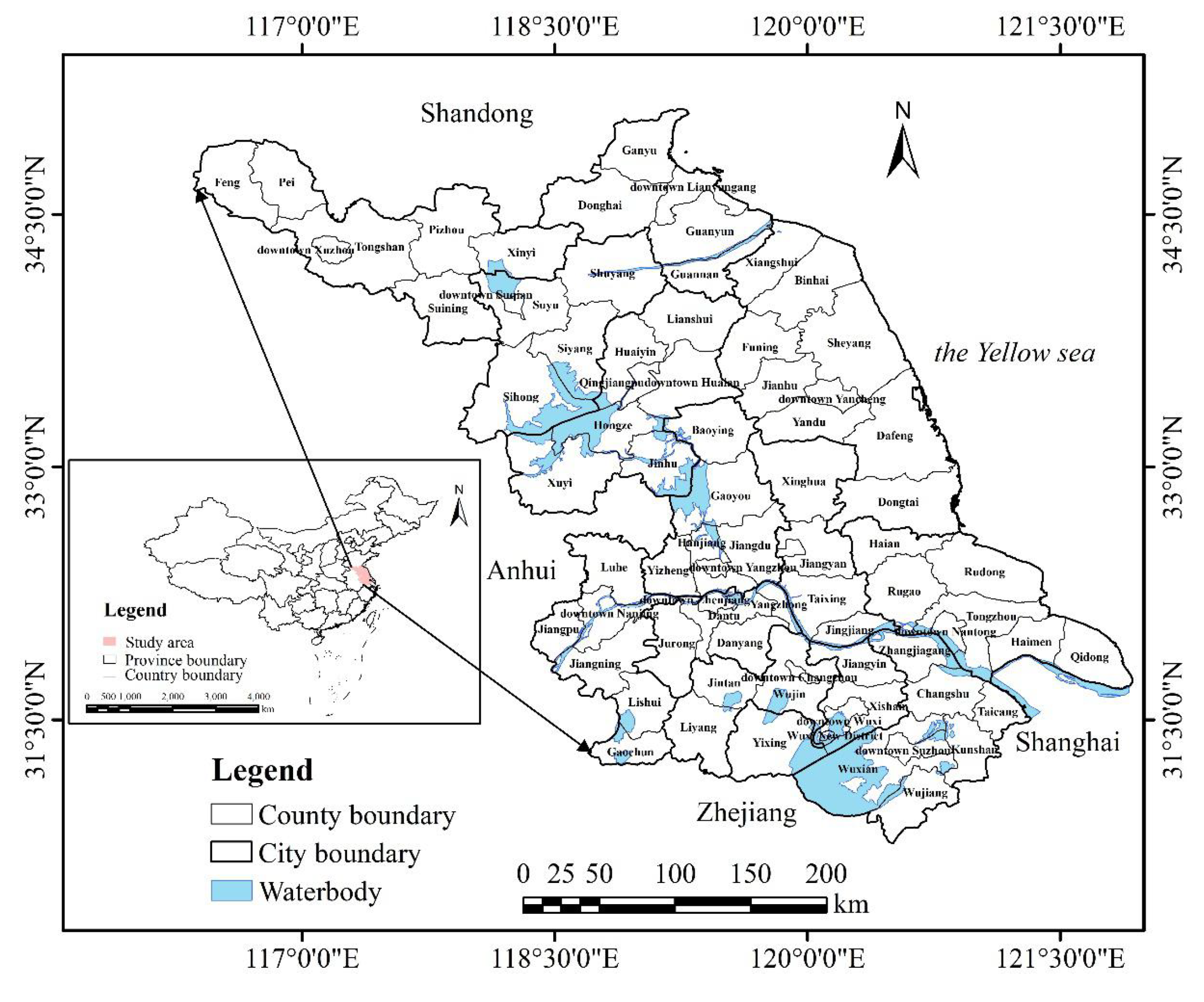
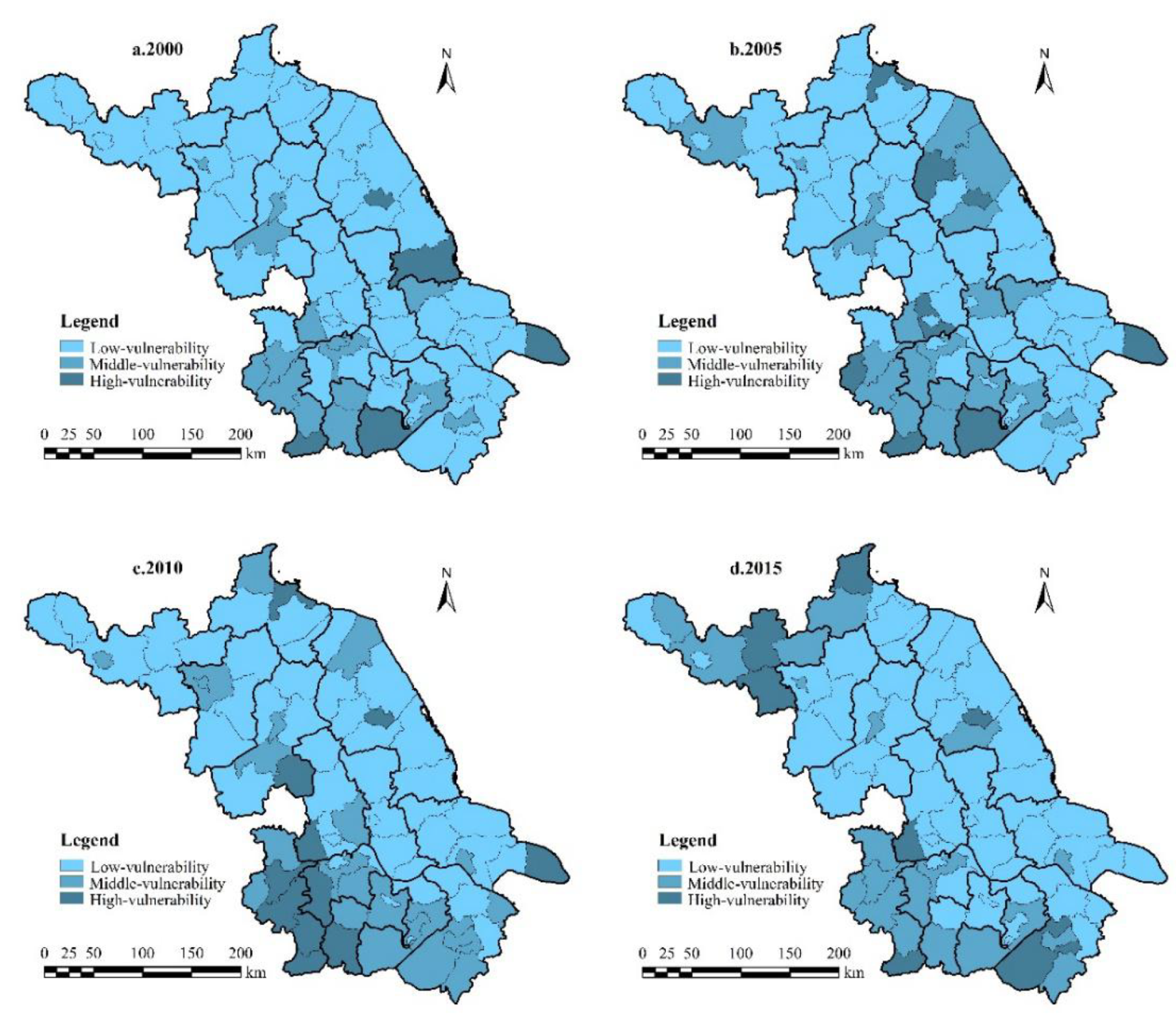

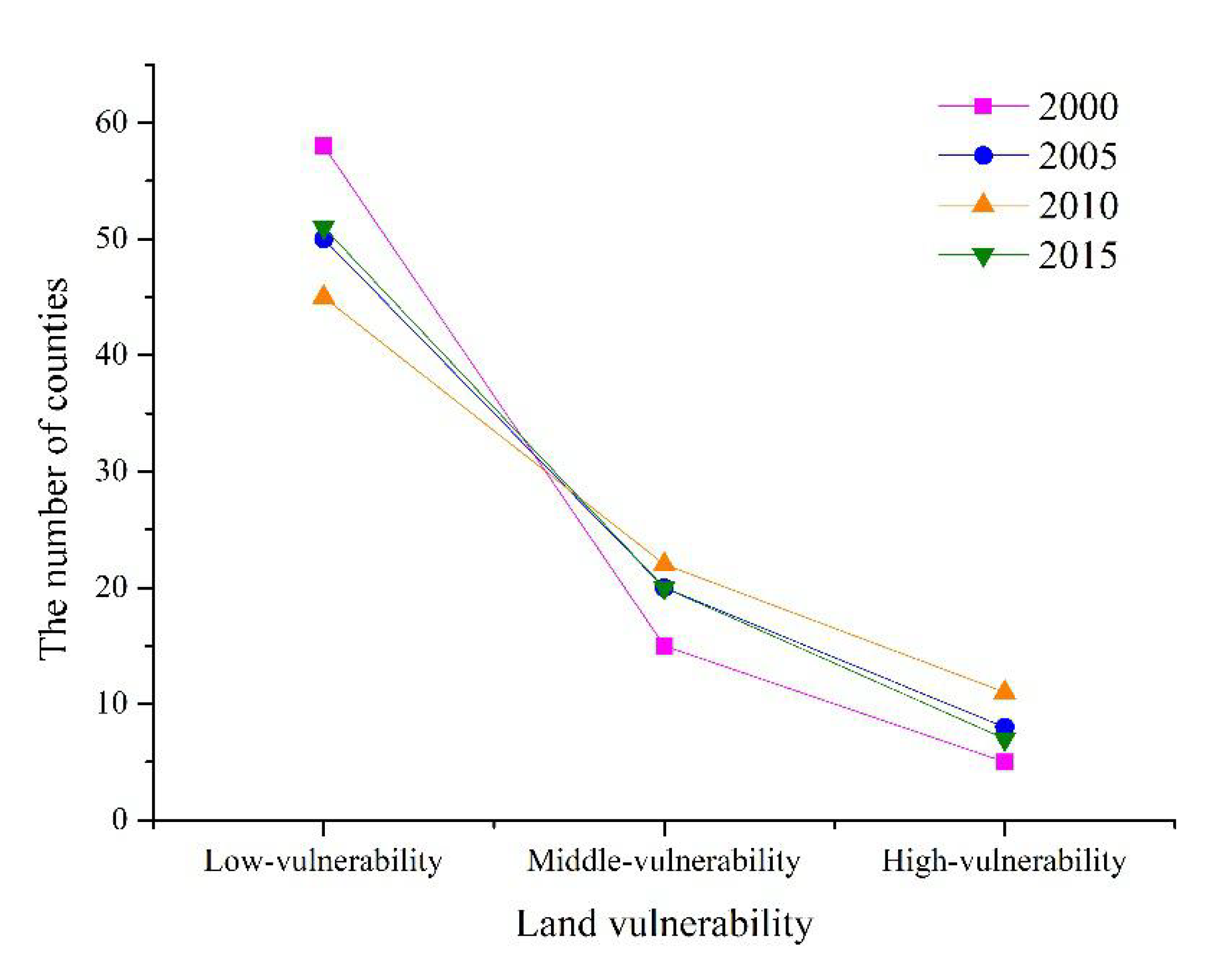
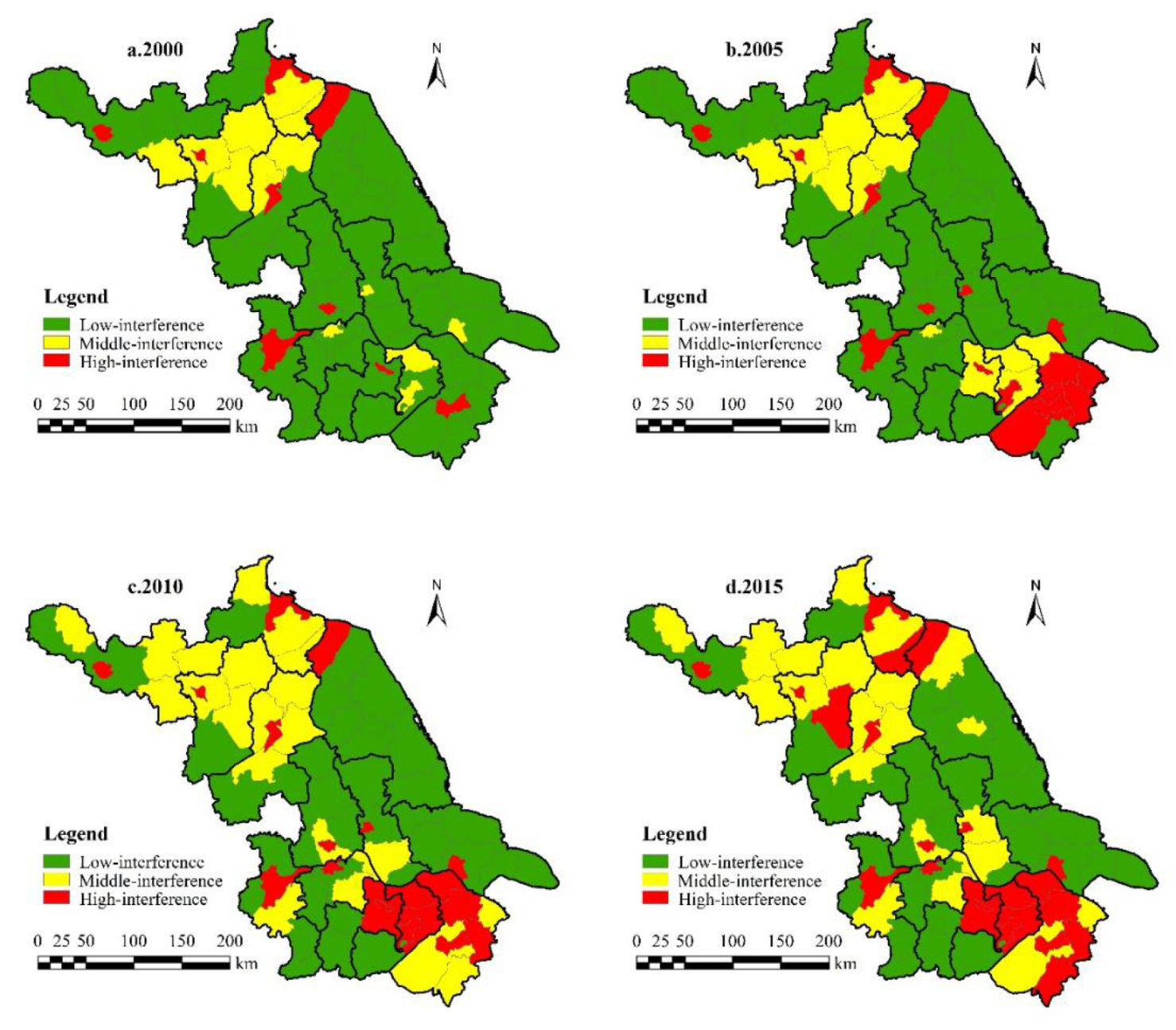
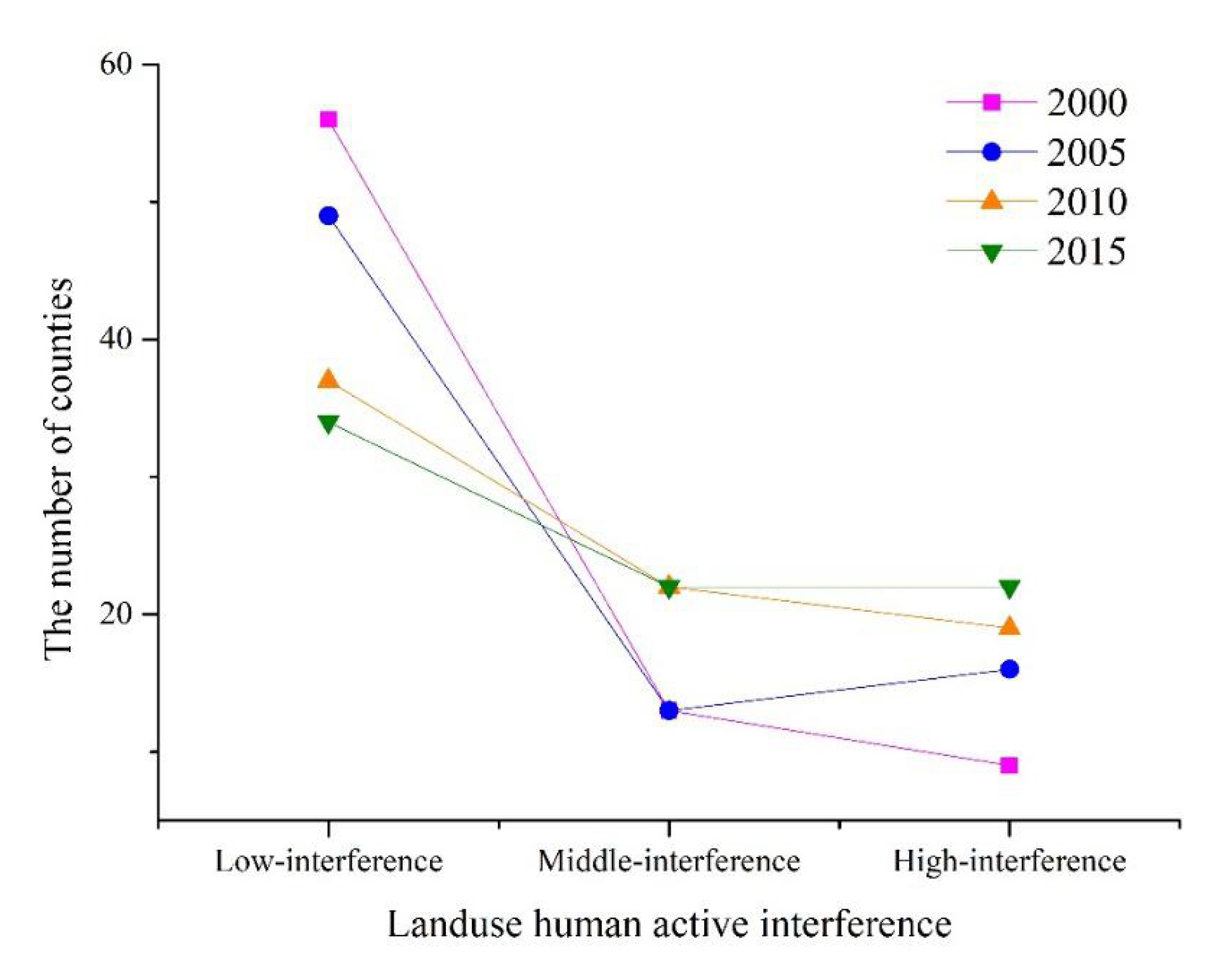

| Landscape Type | Status | Impact Factor |
|---|---|---|
| Cultivated land | Its impact on resources and the environment is small, and some of them are reversible | 0.25 |
| Forest land | It has the function of ecological maintenance and has little impact on resources and environment | 0.1 |
| Grassland | It has the function of ecological maintenance and has little impact on resources and environment | 0.1 |
| Waterbody | Most of the waterbodies belonging to the study area are used for aquaculture and traffic transportation, which are greatly affected by humans and have irreversible impacts on resources and the environment | 0.37 |
| Construction land | It is greatly affected by human activities, most of which are irreversible and have a significant impact on resources and the environment | 0.85 |
| Unutilized land | It has a slight impact on resources and the environment, most of which are irreversible | 0.48 |
| Gravity Center | Moving Direction (°) | Moving Distance (km) |
|---|---|---|
| Positive LVI change rate during 2000–2005 | ||
| Positive LVI change rate during 2005–2010 | −99.21933028 | 97.06707694 |
| Positive LVI change rate during 2010–2015 | 116.5900208 | 172.8695394 |
| Negative LVI change rate during 2000–2005 | ||
| Negative LVI change rate during 2005–2010 | 137.606495 | 128.9835979 |
| Negative LVI change rate during 2010–2015 | −73.63187194 | 53.72771954 |
| Year | The Number of Counties with < 0 | The Number of Counties with > 0 |
|---|---|---|
| 2000–2005 | 33 | 45 |
| 2005–2010 | 33 | 45 |
| 2010–2015 | 56 | 22 |
| Year | LVI | The Change Rate of LVI | LHAI | The Change Rate of LHAI |
|---|---|---|---|---|
| 2000 | 0.054399 | 0.344772 | ||
| 2005 | 0.057817 | 6.282839% | 0.363015 | 5.291249% |
| 2010 | 0.072392 | 25.210100% | 0.372573 | 2.632977% |
| 2015 | 0.090406 | 24.883740% | 0.389341 | 4.500529% |
| During 2000–2005 | During 2005–2010 | During 2010–2015 | Significance | Name | The Number of Counties |
|---|---|---|---|---|---|
| < 0 | < 0 | < 0 | Human activities are always beneficial to the environment | Continuous benefit zone caused by human activities | 10 |
| > 0 | > 0 | < 0 | Human activities have not always been beneficial to the environment, but recently they are good for the environment | Variable benefit zone caused by human activities | 46 |
| > 0 | < 0 | < 0 | |||
| < 0 | > 0 | < 0 | |||
| > 0 | > 0 | > 0 | Human activities are always harmful to the environment | Continuous harmful zone caused by human activities | 10 |
| < 0 | > 0 | > 0 | Human activities have not always been harmful to the environment, but recently they are bad for the environment | Variable harmful zone caused by human activities | 12 |
| > 0 | < 0 | > 0 | |||
| < 0 | < 0 | > 0 |
© 2020 by the authors. Licensee MDPI, Basel, Switzerland. This article is an open access article distributed under the terms and conditions of the Creative Commons Attribution (CC BY) license (http://creativecommons.org/licenses/by/4.0/).
Share and Cite
Zhou, Y.; Pu, L.; Zhu, M. Coastal Landscape Vulnerability Analysis in Eastern China—Based on Land-Use Change in Jiangsu Province. Int. J. Environ. Res. Public Health 2020, 17, 1702. https://doi.org/10.3390/ijerph17051702
Zhou Y, Pu L, Zhu M. Coastal Landscape Vulnerability Analysis in Eastern China—Based on Land-Use Change in Jiangsu Province. International Journal of Environmental Research and Public Health. 2020; 17(5):1702. https://doi.org/10.3390/ijerph17051702
Chicago/Turabian StyleZhou, Yangfan, Lijie Pu, and Ming Zhu. 2020. "Coastal Landscape Vulnerability Analysis in Eastern China—Based on Land-Use Change in Jiangsu Province" International Journal of Environmental Research and Public Health 17, no. 5: 1702. https://doi.org/10.3390/ijerph17051702
APA StyleZhou, Y., Pu, L., & Zhu, M. (2020). Coastal Landscape Vulnerability Analysis in Eastern China—Based on Land-Use Change in Jiangsu Province. International Journal of Environmental Research and Public Health, 17(5), 1702. https://doi.org/10.3390/ijerph17051702




